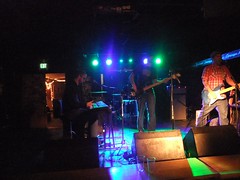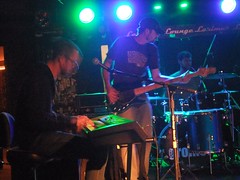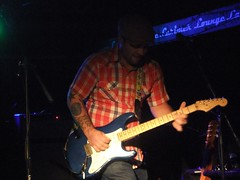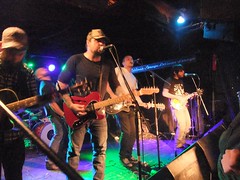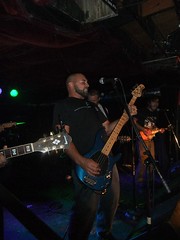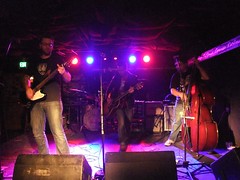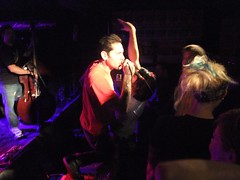12 November 2010 (Aggie Theatre, Ft. Collins CO)Ft. Collins' support for hip hop has been growing and paying off. The national acts coming through are consistently impressive and local acts are developing. Last night's show featured a range of performers that came from all over the stylistic world of hip hop. It was also a kind of victory lap for Seattle rapper Macklemore, who's found a second home base in Colorado.
Jimmy Hands
 Jimmy Hands
Jimmy Hands is on his way to being the house DJ at the Aggie Theatre. He's warmed up for several recent shows there. Having an active DJ filling the musical space before and between sets is a hallmark of hip hop culture. Last night, Hands took an old school approach in picking music to build up the crowd without making himself the center of the experience. He interacted with people, but he mostly kept the music flowing. His song transitions were smooth, with a touch of scratching or bounce mixing. Aside from playing some crowd pleasing rap songs, he also tossed in some wicked electronic grooves.
That's not to say that he didn't step up a bit, though. He sat in with Observatory in what seemed to be a largely unrehearsed backing role. The good-natured riffing during that set was loose and fun. Afterward, he laid out an impressive scratching demo.
Observatory
 Observatory
Observatory is a pair of rappers out of Denver. They took the stage and kept Jimmy Hands up as their DJ. The set started roughly, with some flail working out what he should be play. A less confident group would have been thrown by the confusion, but they rolled with it, teasing each other. This seemed to mesh well for their stage personas as smart asses. A little sarcasm and confrontational attitude set the tone and the audience responded. They challenged the crowd to bring up their energy, which was a good strategy for an opening act.
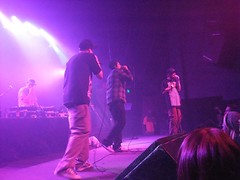
Both guys had some good lyrical flow. Their style seemed more East Coast, with some Beastie Boys vocal influences. The lyrical punches and hand offs were tight and entertaining. They kept the energy high, constantly trading sides of the stage, lunging out to the crowd, and dropping back. It was energetic, but also felt loose.
Later in the set, Observatory had vocalist David Ochoa (Ten Timers) sit in on a song or two, adding an R&B touch to their rap. The set was full of good material. They played one song,
Polaroids, off their MySpace page that I recognized. It had a laid back groove but strong rhythmic flow. Observatory was a good opening act -- strong stage presence, plenty of attitude, and solid skills.
Binary Star

The name is even more appropriate now.
Binary Star is back together after a 10 year break. One Be Lo and Senim Silla made their mark with the underground hit,
Masters of the Universe. Sadly, they split up soon after, each pursuing solo careers. Now the two stars have reunited to capitalize on their old band and show how they've grown since then.
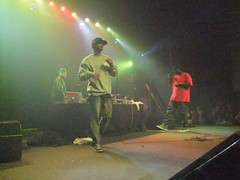
The crowd at the Aggie was already familiar with
Masters of the Universe and they were more than happy to join in on the older songs, including the title cut,
Wolfman Jack, and others. Binary Star rocked it in classic hip hop fashion. The backing grooves weren't surprising but they were always solid. Both guys could nail a strong rolling lyrical flow, sometimes sliding into some gangster attitude. The arrangements were fairly tight, except for the song endings. Too often, the rap ended and the DJ just chopped off the backing track. A little fade or more solid finish would have been better.

One thing for sure is that we could never forget their name. They had us chanting "Binary"-"Star" with them and with each other throughout the set. They judged the crowd well, though, because we didn't mind that at all. Audience participation was key. In
I Know Why the Caged Bird Sings, we drove the tag line, "In jail, without the bail." This song was one of my favorites, setting an auto biographical tone. The peak of the show, though, was when Senim Silla cut loose with some radical fast flow. He deftly rolled through chains of words, with the speed of a Jamaican toaster, but in a more syncopated rhythm. DAMN!
Macklemore (with Ryan Lewis)

A prodigal son returns home as a king.
Macklemore has played Colorado numerous times. A year and a half ago, I
caught him opening for Whiskey Blanket at Hodi's Half Note. As he mentioned last night, there were 20 odd people a night there for those earlier shows. This time, he had a crowd of 400+ at the Aggie. These were serious fans. The audience adored him and in return, he loved us.

How has he made this kind of connection? Like other charismatic grass roots performers, it all comes down to his direct sincerity and openness. He's vulnerable, he shares his weaknesses, and he doesn't pretend to be what he's not. At the same time, he's strong and righteous and he sets a high standard: positive, straight edge, and radical honesty. He sums it up himself in
Vipassana:
So I stare into this paper instead of sitting at a cubicle
Take all the ugly shit inside and try to make it beautiful
Use the cement from rock bottom and make it musical
So the people can relate to where I've been
Where I'm going, what I've seen, what I've heard
From the guts, fuck the glory
Just a person on a porch putting it all into recording
Many in my past and many that came before me
I just keep walking my path and blessed to share my story
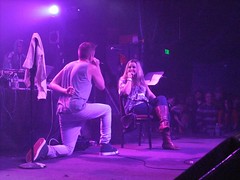
In contrast to this kind of seriousness, though, he also has a sheer joy and exuberance at being on stage. He has a natural feel for the audience, whether it's having them sing along on
Hold Your Head Up or getting a volunteer for the novelty song
Stay At Home Dad. The mood shifts between humor, happiness, frantic energy, confessional revelations, and spiritual truths. Sometimes, Macklemore hits the same sweet spot as Michael Franti, with a sheen of positivity and syncopated delivery. His high school prom song,
The End, has some Franti rhythms, a wistful feel, and even a sense of spirituality. The live horn solo was perfect.
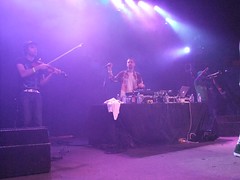
That brings us to tour personnel. Macklemore had DJ/producer Ryan Lewis backing him, along with Andrew Joslyn (violin) and Owuor Arunga (trumpet). The live instruments were subtle but strong additions to the show, adding a touch of magic. Lewis has had a big influence on Macklemore's studio work, but he kept to a supporting role on stage.

The group closed on Macklemore's
favorite encore pair: the campy
And We Danced performed in the persona of Sir Raven Bowie and
Irish Celebration. It was him the whole fucking time.
Many more photos on my
Flickr.
 Band EPs often show a range of styles. The three songs on the Stoner EP by Valleys are each an amalgam of genres, but together they set a consistent tone. Despite some elements of post punk and indie rock, the main sound is a heady psycho-progressive rock. The clearest comparison would be And You Will Know Us By The Trail Of Dead, but that misses the contrasting calm moments that set up the catharsis.
Band EPs often show a range of styles. The three songs on the Stoner EP by Valleys are each an amalgam of genres, but together they set a consistent tone. Despite some elements of post punk and indie rock, the main sound is a heady psycho-progressive rock. The clearest comparison would be And You Will Know Us By The Trail Of Dead, but that misses the contrasting calm moments that set up the catharsis.






















